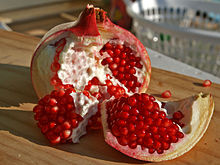նուռն
Appearance
Old Armenian
[edit]
Etymology
[edit]From Hurrian 𒉡𒊏𒀭𒋾 (nu-ra-an-ti /nuranti/, “pomegranate”), which is related to Hittite 𒉡𒊏𒋾 (/nurati-/), and Akkadian 𒉡𒊑𒅎𒁺 (nu-ri-im-du /nurimdu, nurimtu/, “pomegranate”), Sumerian 𒉡𒌫𒈠 (NU-UR2-MA /nurma/), Akkadian 𒉡𒌫𒈠 (NU-UR2-MA /nurmû/, “pomegranate”). See Arabic رُمَّان (rummān) for another order of the consonants.
Noun
[edit]նուռն • (nuṙn)
- pomegranate fruit
- նռան ծաղիկ ― nṙan całik ― flower of wild pomegranate-tree
- 5th century, Agatʻangełos, Patmutʻiwn Hayocʻ [History of the Armenians] 644:[1][2]
- Սոյնպէս կիտրոնն եւ ապաբաղսամոնն եւ դափնին եւ ձիթենին գեղեցիկ եւ սերկեւիլն եւ մուրտն եւ ընկոյզն եւ նուշն եւ քնարուկն եւ հաճարուկն եւ թութն եւ նուռնն եւ հոյնն:
- Soynpēs kitronn ew apabałsamonn ew dapʻnin ew jitʻenin gełecʻik ew serkewiln ew murtn ew ənkoyzn ew nušn ew kʻnarukn ew hačarukn ew tʻutʻn ew nuṙnn ew hoynn:
- Translation by Robert W. Thomson
- Likewise the lemon and balsamon, and laurel and beautiful olive tree, and quince and myrtle, and nut and almond, and lotus and holly, and mulberry and pomegranate and cornel tree.
- Սոյնպէս կիտրոնն եւ ապաբաղսամոնն եւ դափնին եւ ձիթենին գեղեցիկ եւ սերկեւիլն եւ մուրտն եւ ընկոյզն եւ նուշն եւ քնարուկն եւ հաճարուկն եւ թութն եւ նուռնն եւ հոյնն:
Declension
[edit]| singular | plural | |
|---|---|---|
| nominative | նուռն (nuṙn) | նռունք, նռնունք (nṙunkʻ, nṙnunkʻ) |
| genitive | նռան (nṙan) | նռանց (nṙancʻ) |
| dative | նռան (nṙan) | նռանց (nṙancʻ) |
| accusative | նուռն (nuṙn) | նռունս, նռնունս (nṙuns, nṙnuns) |
| ablative | նռանէ (nṙanē) | նռանց (nṙancʻ) |
| instrumental | նռամբ (nṙamb) | նռամբք (nṙambkʻ) |
| locative | նռան (nṙan) | նռունս, նռնունս (nṙuns, nṙnuns) |
The nominative plural նռնունք (nṙnunkʻ) is post-classical.
Derived terms
[edit]Descendants
[edit]- Armenian: նուռ (nuṙ)
References
[edit]- ^ Agatʻangełos (1909) G. Tēr-Mkrtčʻean and St. Kanayeancʻ, editors, Patmutʻiwn Hayocʻ [History of Armenia] (Patmagirkʻ hayocʻ; I.2)[1], Tiflis: Mnacʻakan Martiroseancʻ Press, page 330
- ^ Thomson, Robert W. (2001) The teaching of Saint Gregory (Avant: Treasures of the Armenian Christian Tradition; 1), revised edition, New Rochelle, New York: St. Nersess Armenian Seminary, page 206
Further reading
[edit]- Ačaṙean, Hračʻeay (1971–1979) “նուռն”, in Hayerēn armatakan baṙaran [Armenian Etymological Dictionary] (in Armenian), 2nd edition, a reprint of the original 1926–1935 seven-volume edition, Yerevan: University Press
- Diakonoff, Igor M. (1985) “Hurro-Urartian Borrowings in Old Armenian”, in Journal of the American Oriental Society[2], volume 105, number 4, pages 597–603
- J̌ahukyan, Geworg (1987) Hayocʻ lezvi patmutʻyun; naxagrayin žamanakašrǰan [History of the Armenian language: The Pre-Literary Period][3] (in Armenian), Yerevan: Academy Press, page 426
- J̌ahukyan, Geworg (2010) “նուռն”, in Vahan Sargsyan, editor, Hayeren stugabanakan baṙaran [Armenian Etymological Dictionary] (in Armenian), Yerevan: Asoghik, page 574a
- Petrosean, Matatʻeay (1879) “նուռն”, in Nor Baṙagirkʻ Hay-Angliarēn [New Dictionary Armenian–English], Venice: S. Lazarus Armenian Academy
- Thorsø, Rasmus (2023) Prehistoric loanwords in Armenian: Hurro-Urartian, Kartvelian, and the unclassified substrate[4], PhD dissertation, Leiden University, page 17
